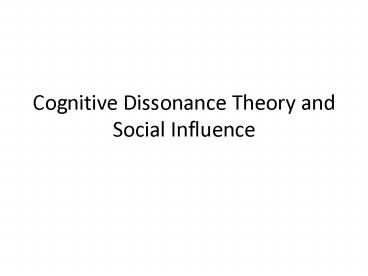Cognitive Dissonance Theory and Social Influence - PowerPoint PPT Presentation
1 / 22
Title:
Cognitive Dissonance Theory and Social Influence
Description:
Some norms are written into law or official rules. Others are more unwritten expectations enforced by teasing, frowns, ostracism ... – PowerPoint PPT presentation
Number of Views:442
Avg rating:3.0/5.0
Title: Cognitive Dissonance Theory and Social Influence
1
Cognitive Dissonance Theory and Social Influence
2
Cognitive Dissonance
3
Cognitive Dissonance Theory
- Leon Festinger (1957)
- Exists whenever a person has two contradictory
cognitions (or beliefs) at the same time - Example
- I am a loyal and considerate friend.
- Yesterday I repeated some juicy gossip I heard
about my friend.
4
- Two cognitions are dissonant
- Each one implies the opposite of the other
- According to Festinger, cognitive dissonance
creates unpleasant psychological tension - Tension motivates the individual to try to
resolve the dissonance in some way
5
How?
- Changing ones attitude is the easiest way to
reduce discomfort - Example
- Chris is not really my friend, he is more of an
acquaintance. - My attitude now fits my new behavior
- Spreading gossip about someone who is not a true
friend does not contradict that I am a loyal and
considerate friend.
6
OR
- I need to discuss this news in order to
determine if this news is true about Chris. - OR Terry doesnt know Chris so therefore it is
ok to talk about Chris. - OR Small bribes reduce dissonant behavior
7
Leon Festinger
8
Norms
9
Norms
- Cultural Norm the behavioral rules shared by an
entire society - Behavior is also shaped by the norms of smaller
organizations (like the Goth kids), such as
families, teams and communities - Norm A shared idea or expectation about how to
behave
10
- Some norms are written into law or official rules
- Others are more unwritten expectations enforced
by teasing, frowns, ostracism and other informal
means of punishment - Without NORMS life would be chaotic
- With them behavior becomes predictable despite
great differences in underlying attitudes and
preferences - http//www.youtube.com/watch?vjaugP7codEo
11
Conformity
12
Conformity
- Conformity Voluntarily yielding to social
norms, even at the expense of ones own
preference. - Implies a conflict between the individual and the
group a conflict that people resolve by
yielding their preferences or beliefs to the
norms or expectations of a larger group.
13
Solomon Asch1950s
14
- http//www.youtube.com/watch?vR6LH10-3H8k
- Solomon Asch conducted the first systematic study
of the subject. - He demonstrated in a series of experiments that
under some circumstances people will conform to
group pressures even if this forces them to deny
obvious physical evidence
15
Results
- Overall, participants conformed 35 of the
trials - 2 Important variables
- 1. Characteristics of the situation
- Size likelihood of conformity increased until
the size of the group reached four confederates. - After that number made no difference in the
participants tendency to ignore the evidence
with their own eyes - Nature of the task task is difficult or poorly
defined, conformity tended to be higher - 2. Characteristics of the individual
- The more an individual is attracted to a group,
expects to interact with that group in the
future, holds a relatively low status in the
group, and does not feel completely accepted by
the group, the more the that person tends to
conform.
16
Compliance
- Compliance a change in behavior in response to
an explicit request from another person or group.
17
3 Techniques
- How do you get people to comply?
- 1. Foot-in-the-Door Effect Once people have
granted a small request, they are more likely to
comply with a larger one. - This technique realigns the participants self
perception slightly to that of someone who favors
the cause
18
- 2. Lowball Procedure steps
- Step 1 Induce a person to agree to something
- Step 2 Raise the cost of compliance
19
- 3. Door-in-the-Face Effect A person who refuses
to comply with one request may be more likely to
comply with a second. - If saying no to the first request made you feel
guilty, you may say yes to something else.
20
Obedience
- Obedience is a change in behavior in response
to a command from another person, typically an
authority figure.
21
Milgram
- http//www.youtube.com/watch?vy6GxIuljT3wfeature
PlayListpC2887F2E31246625playnext1playnext_f
romPLindex10 - Factors that contribute to obedient behavior
- Presence of a uniform
- Surveillance people need to be watched
- Diffusion of responsibility
- Why?
- People see themselves as agents of another
persons wishes and therefore not responsible for
their own actions or consequences.
22
Why?
- People see themselves as agents of another
persons wishes and therefore not responsible for
their own actions or consequences. - Once this shift in self perception occurs
obedience follows. - How to tell authority figure is treacherous?































